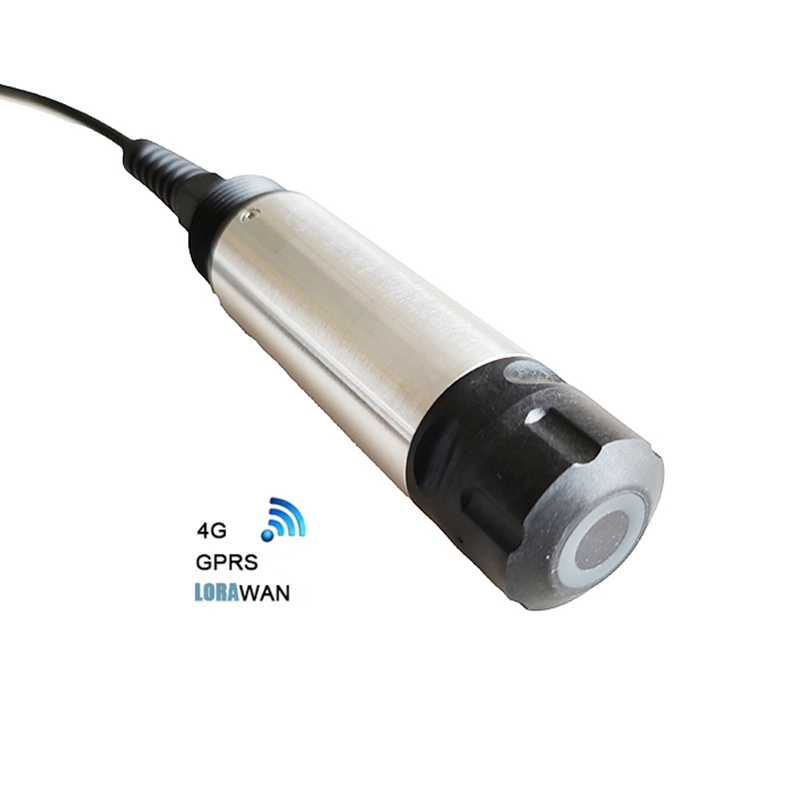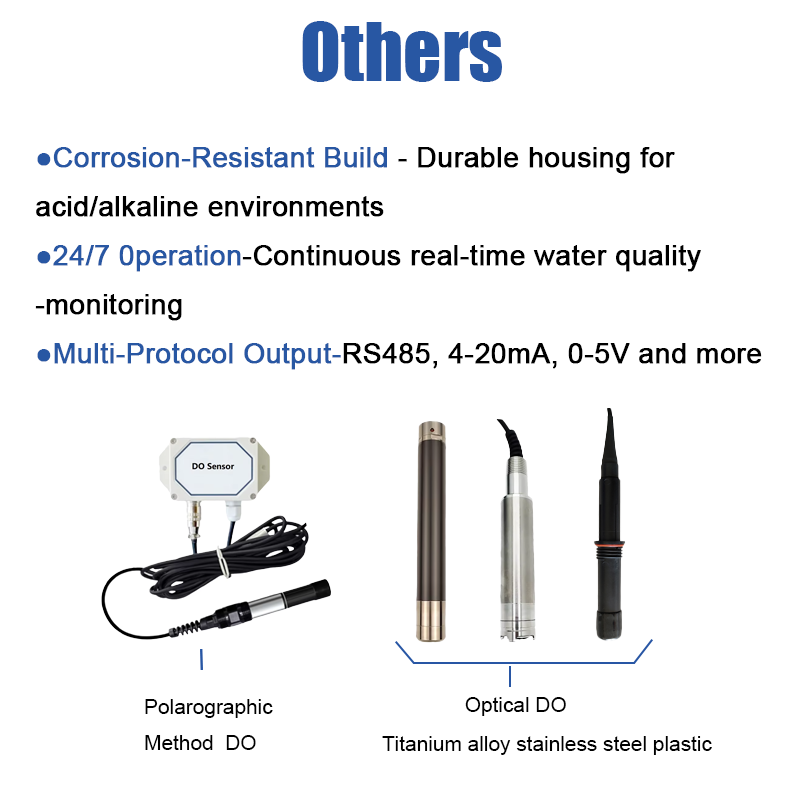Optical Dissolved Oxygen (ODO) sensors, also known as fluorescence-based sensors, are a modern technology that contrasts with traditional membrane electrode methods (Clark cells). Their core feature is the use of fluorescence quenching to measure the concentration of dissolved oxygen in water.
Working Principle:
The sensor’s tip is covered with a membrane impregnated with a fluorescent dye. When this dye is excited by a specific wavelength of blue light, it emits red light. If oxygen molecules are present in the water, they collide with the excited dye molecules, causing a reduction in the fluorescence intensity and a shorter fluorescence lifetime. By measuring this change in fluorescence lifetime or intensity, the dissolved oxygen concentration can be accurately calculated.
Key Characteristics:
- No Oxygen Consumption, No Electrolyte:
- This is the most fundamental difference from the membrane electrode method. Optical sensors do not consume oxygen from the sample, providing more accurate results, especially in low-flow or static water bodies.
- There is no need to replace electrolytes or membranes, significantly reducing maintenance.
- Low Maintenance, High Stability:
- No issues with membrane clogging, electrode poisoning, or electrolyte contamination.
- Long calibration intervals, often requiring calibration only every few months or even longer.
- Fast Response and High Accuracy:
- Very quick response to changes in dissolved oxygen, enabling real-time capture of dynamic water quality changes.
- Measurements are not affected by flow velocity or interfering substances like sulfides, offering superior accuracy and stability compared to traditional methods.
- Minimal Long-Term Drift:
- The properties of the fluorescent dye are very stable, resulting in minimal signal drift and ensuring long-term measurement reliability.
- Ease of Use:
- Typically plug-and-play, with no lengthy polarization time required after startup; ready for immediate measurement.
Disadvantages:
- Higher Initial Cost: Typically more expensive than traditional membrane electrode sensors.
- Fluorescent Membrane has a Finite Lifespan: Although long-lasting (usually 1-3 years), the membrane will eventually photodegrade or become fouled and require replacement.
- Potential Fouling by Oils and Algae: Heavy coating of oil or biofouling on the sensor surface can interfere with light excitation and reception, necessitating cleaning.
2. Application Scenarios
Due to their excellent characteristics, optical dissolved oxygen sensors are widely used in various fields requiring continuous and precise DO monitoring:
- Wastewater Treatment Plants:
- A critical application. Used to monitor DO in aeration tanks and aerobic/anaerobic zones to optimize aeration, enabling precise control for energy savings and improved treatment efficiency.
- Natural Water Body Monitoring (Rivers, Lakes, Reservoirs):
- Used in environmental monitoring stations to assess a water body’s self-purification capacity, eutrophication status, and potential hypoxia, providing data for ecological protection.
- Aquaculture:
- DO is the lifeline of aquaculture. Optical sensors enable 24/7 monitoring in ponds and tanks. They can trigger alarms and automatically activate aerators when levels drop too low, preventing fish kills and safeguarding production.
- Scientific Research:
- Used in oceanographic surveys, limnological studies, and ecotoxicology experiments where high-precision, low-interference DO data is essential.
- Industrial Process Water:
- In systems like power plant and chemical plant cooling water, monitoring DO to control corrosion and biofouling.
3. Application Case Study in the Philippines
As an archipelagic nation, the Philippines’ economy relies heavily on aquaculture and tourism, while also facing water pollution challenges from urbanization. Therefore, water quality monitoring, especially for dissolved oxygen, is critically important.
Case Study: Smart DO Monitoring and Aeration System in Laguna de Bay Aquaculture Zones
Background:
Laguna de Bay is the largest lake in the Philippines, with surrounding areas being crucial for aquaculture, primarily for Tilapia and Milkfish (Bangus). However, the lake faces threats from eutrophication. During hot summer months, water stratification can lead to hypoxia in deeper layers, often causing massive fish kills (“fish kills”), resulting in significant economic losses for farmers.
Application Solution:
The Bureau of Fisheries and Aquatic Resources (BFAR), in collaboration with local governments, promoted the use of an intelligent water quality monitoring and control system based on optical dissolved oxygen sensors in large-scale commercial farms and key areas of the lake.
System Components and Workflow:
- Monitoring Nodes: Multi-parameter water quality buoys equipped with optical DO sensors were deployed at various points in fish ponds (especially in deeper areas) and key locations in the lake. These sensors were chosen because:
- Low Maintenance: Their long maintenance-free operation is ideal for areas with limited technical staff.
- Resistance to Interference: Less prone to failure from fouling in organically rich and turbid aquaculture waters.
- Real-time Data: Capable of providing data every minute, allowing for the quick detection of sudden DO drops.
- Data Transmission: Sensor data is transmitted in real-time via wireless networks (e.g., GPRS/4G or LoRa) to a cloud platform and farmers’ mobile apps.
- Smart Control and Early Warning:
- Platform Side: The cloud platform is set with DO alarm thresholds (e.g., below 3 mg/L).
- User Side: Farmers receive audible/visual alerts, SMS, or app notifications.
- Automatic Control: The system can automatically activate aerators until DO levels are restored to a safe range.
Outcomes:
- Reduced Fish Mortality: Early warnings and automatic aeration successfully prevented multiple fish kill events caused by critically low DO levels during the night or early morning.
- Improved Farming Efficiency: Farmers can manage feeding and aeration more scientifically, reducing electricity costs (by avoiding 24/7盲目 operation of aerators) and improving feed conversion ratios and fish growth rates.
- Data for Environmental Management: Monitoring stations in the lake provide BFAR with long-term spatiotemporal DO data, helping to analyze eutrophication trends and formulate more scientific lake management policies.
Summary:
In developing countries like the Philippines, where aquaculture faces high risks and infrastructure can be challenged, optical dissolved oxygen sensors have proven to be an ideal technological tool for precision aquaculture and smart environmental management due to their durability, low maintenance, and high reliability. They not only help farmers mitigate risks and increase income but also provide powerful data support for protecting the Philippines’ precious aquatic ecosystems.
We can also provide a variety of solutions for
1. Handheld meter for multi-parameter water quality
2. Floating Buoy system for multi-parameter water quality
3. Automatic cleaning brush for multi-parameter water sensor
4. Complete set of servers and software wireless module, supports RS485 GPRS /4g/WIFI/LORA/LORAWAN
For more SENSOR information,
please contact Honde Technology Co., LTD.
Email: info@hondetech.com
Company website: www.hondetechco.com
Tel: +86-15210548582
Post time: Oct-30-2025



